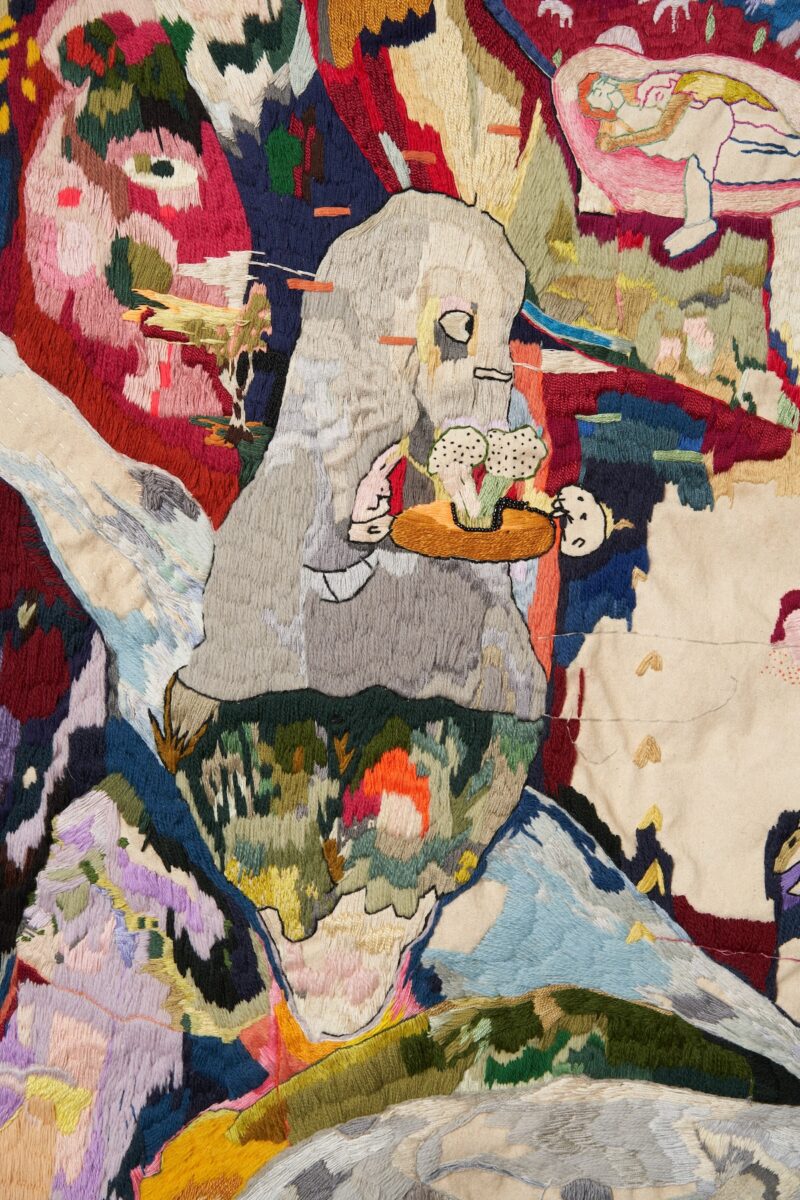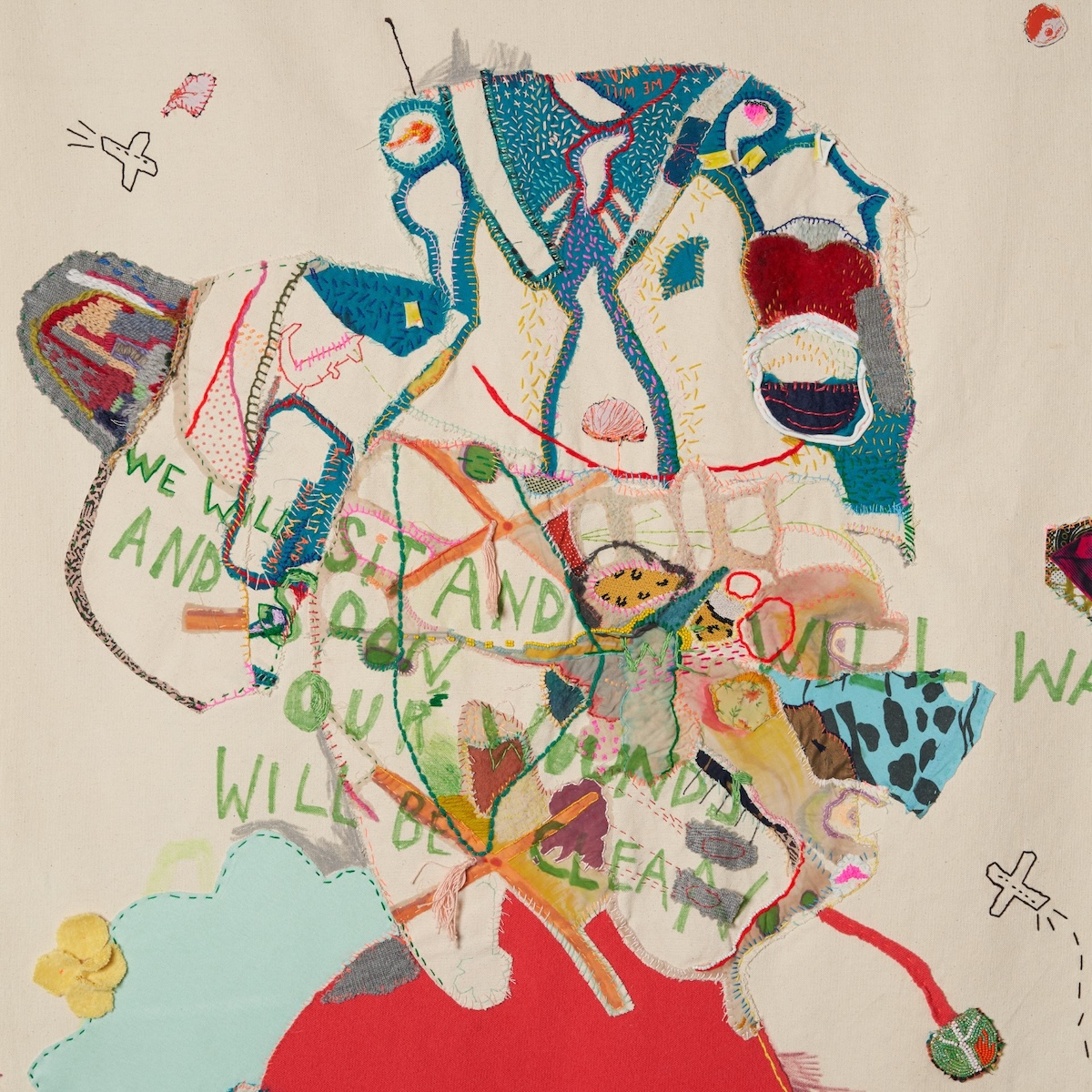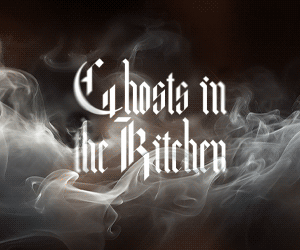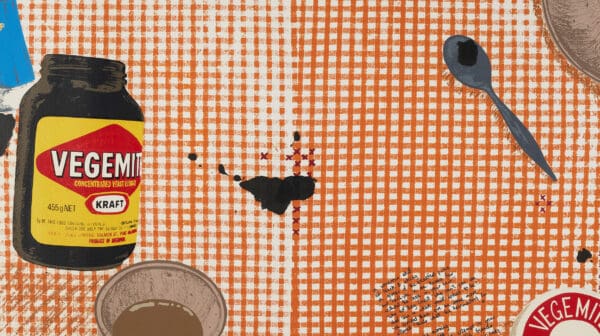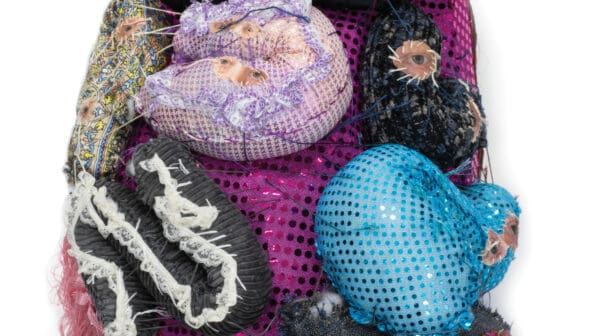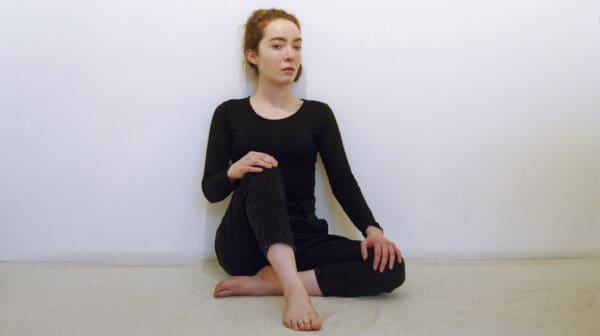Much like the process of a magpie collecting detritus to adorn its world, Kasia Töns deliberately threads together disparate discards of the day to create modular, soft, safe havens that defy expectations of dwellings as we know them.
Currently housed at Ararat Gallery TAMA is Panoply, Töns’s textile sculptures which welcome onlookers past a gallery-centric look-but-don’t-touch threshold. These visionary works predict communal notions of safety for times of strife. The nucleus is Panoply II, an alternative disaster shelter at human scale, consolidating decades of time spent embroidering.
Manoeuvring needle and thread over these extended periods, Töns has often pondered how we might live a “more connected and harmonious existence with nature”. Much like a sci-fi writer bringing to fruition what might otherwise be, this habitualised act of looking to the past to imagine the future conceives something both strangely divergent and urgently topical.
Influenced by hosting mask making workshops, with Töns adapting fabric manipulation methods to the emotional and physical needs of the attendants, Panoply prompts a re-evaluation of accessible security and what forms we might imagine to defend us during the Anthropocene.
Töns begins our interview by acknowledging nearby bushfire smoke, hanging thick in the air of the Victorian town of Ararat, her location nearby the gallery providing significant context to the climate issues which propel her timely interrogations.
Usually, home for Töns is a yurt which she shares with her dog in the Adelaide Hills of South Australia. A focus on alternative dwellings is a central purpose for the artist, extending lived experience into artistic praxis. Her obsession with centuries-old methods of textile architecture, and the “…affordable, transportable and accessible methods of transforming spaces”, also apply to her art studio; a second home. Decorating it with swathes of cloth to fabricate protective nooks, Töns spends valuable time there among the intentional community of 20 artists—a prerequisite for a practice fertilised by lived experiences of others.
The premise for Panoply grew out of narrative-based workshops run by Töns. “They were a chance for people who don’t get to tell a story to have a voice,” she remembers. “Talking to participants who had gone through times of displacement about what made them feel safe and their hopes for the future—I created a mask for each of them, in response to their needs.”
Pursuing this idea of needs-based making, Panoply II resembles a life-size, womb-like cubby-hole, modular in its formation and based on the size of a standard emergency shelter. Made up of five parts and moveable on wheels, Töns explains that “the intention is that it is able to join other panoplies by the doorway connecting points”. Salvaged silks, cottons and stuffings become united via a system of pronounced and unwieldy threads, reminders that Töns’s inherent predilection for recycled materials is a foundational ethos. Caring for our earth and the things upon it, embraces the possibilities that these forsaken objects still retain. This consideration is a poignant reminder that our waste will ultimately outlive us, not the other way around. Perhaps, in the meantime, it might come to protect us from ourselves too.
“It grows as I grow. These are records of what I’ve learned, seen, experienced.”
Beyond Homeostasis, Töns’s embroidery which was exhibited at MARS Gallery in Melbourne earlier this year, elucidates her zero-waste mentality: “That was a tent I was living in. I don’t like to get new materials. I like things that come with a feeling already— a memory attached to it.” Of its gaping entryway and zippers still intact—although undeniably re-imagined— Töns maintains that “To get to know something is to sleep in it or inhabit it.”
Reminiscing that as a child her diaries were at risk of being read by others, Töns began writing in self-made code. Growing out of a need for a language of one’s own, embroidery became a parallel intention. “That’s what I love about the history of textiles,” she shares. “You’ve got to be invited into the information. It’s storytelling at the heart of a community… but an outsider might not be able to know the meaning of those stories.”
Töns points out that this is an embodied, living process: “It grows as I grow. These are records of what I’ve learned, seen, experienced.” Gathering the essential and fleeting materials which make up a life— time, memory, involvement—Töns transposes these upon her materials. “I’ll come across something from five years ago that has a significant memory attached and I’ll integrate it. The narrative becomes not of any particular time or place. It’s past, future and present in one. That’s how we experience life, this overlapping of moments, trying to make sense of it all.”
This tale of textiles inscribes a story of protective power. A shield against uncertainty, a crucial anchor. Töns concludes: “You can take your imagination and make art anywhere, out of anything. It can be the only consistent thing in your life, when everything’s unfamiliar and uncertain. Having the ability to draw a picture, embroider or even make a sandcastle, it’s something to make you feel safe and like yourself. You can make sense of everything again.” It’s a life lived in consideration of why what we make matters, and, crucially, why what we waste should matter so much more.
Panoply
Kasia Töns
Ararat Gallery TAMA
On now—16 June
This article was originally published in the May/June 2024 print edition of Art Guide Australia.







